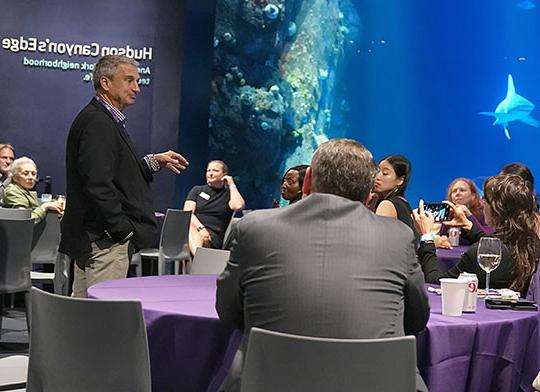Alfred University, Silica-X tout environmental impact of novel concrete made with waste glass

Concrete fortified with waste glass material, developed by glass scientists in Alfred University’s Inamori School of Engineering, was unveiled Thursday, August 8, at a press conference and reception at the New York Aquarium in Brooklyn. The novel concrete material, created through a research partnership between Alfred University, the New York State Department of Environmental Conservation (DEC) and Silica-X, is expected to have far-reaching environmental benefits.
Silica-X is a Spokane, WA-based company specializing in the elimination of waste streams by using them to create economically desirable, planet-friendly materials from silica—the second-most abundant compound on Earth. The company develops technology and systems that enable industry to reclaim hundreds of millions of tons of industrial waste each year, turning it into valuable resources.
In the fall of 2022, glass scientists Alfred University, led by Collin Wilkinson, assistant professor of glass science and director of the Inamori School of Engineering’s Center for Glass Innovation—in partnership with New York State and Silica-X—began researching ways to develop a novel concrete made from cement fortified with waste glass particles. The research is supported by the DEC, which awarded Alfred University $4.2 million from its Environmental Protection Fund. Funding supports research, in partnership with private enterprise, aimed at promoting glass recycling and reuse.
“This will be incredibly significant, we believe, for the state of New York and the broader world,” said Mark Zupan, Alfred University president. “When it comes to sustainability, we’re proud to partner with the DEC, SUNY and Silica-X on this innovative technology. We’re delighted with the impact this will have on the state of New York.”
One of the goals of the DEC-funded glass sustainability project is to develop new “sinks,” or products which make use of recycled glass. The collaboration between Alfred University and Silica-X studies how waste glass particles replace traditional materials (finely crushed limestone) used in the production of cement.
Wilkinson described the process of making traditional Portland cement—which requires using a carbon-based fuel, natural gas, to burn off carbon from limestone—“one of the worst manufacturing processes for carbon emissions.”
Using alternative materials, such as waste glass, in creating cement is less harmful to the environment.
This innovation can best be described as the first-ever Roman Concrete analog, with significantly longer life spans and reduced material weight as compared to traditional concrete widely used today. Researchers at Alfred University and Silica-X officials believe the novel concrete will stand up to the rigors of a marine environment better than concrete made from Portland cement and has the potential to replace traditional concrete in the manufacture of sea walls and, eventually, as a primary building material in coastal communities around the globe.
Video documentary on the Alfred University-Silica-X research on waste glass-fortified concrete
“This is the reason we’re excited: being able to use waste materials to create a buffer layer that protects the things we really care about,” Wilkinson commented. “This work has been a collaboration across many years, with many people. As a result, we’re looking at new jobs, new activities, and new environmental benefits in the name of innovating to solve our greatest challenges.”

Collin Wilkinson, assistant professor of glass science and director of the Center for Glass Innovation at Alfred University, discusses the environmental benefits of a concrete fortified with waste glass developed through research at the University in partnership with Silica-X.
Samples of this Roman-derived concrete made from glass-fortified cement—in the form of four cubic foot blocks called “coupons”—will be placed in the Long Island Sound in early October to test its robustness in the marine environment. The coupons will be studied regularly for two years. The test coupons are designed to encourage sea life propagation, supporting ocean ecology. It is further anticipated that manufacturing of this innovative concrete, by Silica-X, which has produced these initial test coupons, will be done locally, resulting in the creation of new, green jobs, while reducing the environmental impacts of shipping concrete to Long Island and waste glass off the Island.
Officials pointed to the importance of developing a “circular economy,” in which products are continuously reused in the manufacture of other products, thus significantly decreasing waste streams.
“This team (Alfred University glass scientists, Silica-X) is on the verge of introducing a first-of-its-kind technology that can have a significant impact not just on New York, but also becoming a model for the world,” remarked Philip Galland, CEO of Silica-X. “We took cutting edge technology and applied it to a modern-day problem we’re all facing and we’re on the verge of a solution that is environmentally, ecologically, and economically resilient. It’s biologically receptive, it’s very low carbon and its superpower is it's made out of garbage. It’s made out of waste streams that are headed for landfills. This will be the de facto model for the circular economy.”

Philip Galland, CEO of Silica-X, talks about the partnership between his company and Alfred University to study ways to create a groundbreaking new concrete fortified with waste glass and the positive impact it will have on the environment.
“This project is about creating a greener economy in New York State by incorporating waste glass into concrete that we hope can be used in aquatic applications. This work is critical for us as we try to create a circular economy here in New York State,” said Patrick Foster, DEC deputy commissioner for Materials Management and Environmental Remediation. “As a national leader in glass research and education, Alfred University is working to improve the quality of recycled glass and glass markets throughout New York State. They are tackling many important issues, helping us toward a circular waste economy.”
